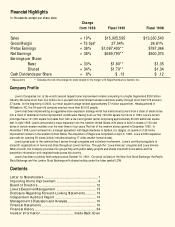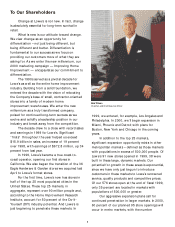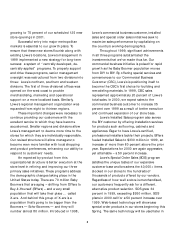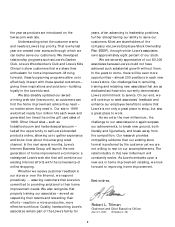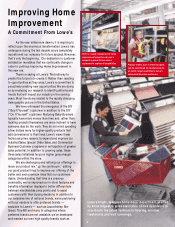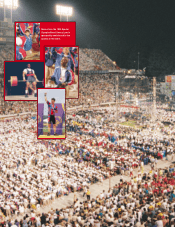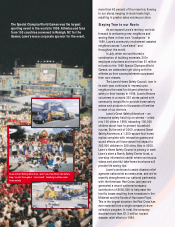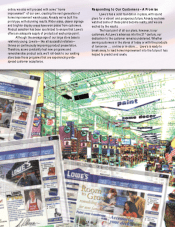Lowe's 1999 Annual Report Download - page 4
Download and view the complete annual report
Please find page 4 of the 1999 Lowe's annual report below. You can navigate through the pages in the report by either clicking on the pages listed below, or by using the keyword search tool below to find specific information within the annual report.2
grow ing to 75 percent of our scheduled 125 new
store openings in 2001.
Successful entry into major metropolitan
markets is essential to our grow th plans. To
ensure that these new stores flourish along w ith
existing Lowe’s locations, Lowe’s management in
1999 implemented a new strategy for long-term
success: a system of “ centrally developed, de-
centrally applied” programs. To properly support
and drive these programs, senior management
oversight w as restructured from tw o divisions into
three: Lowe’s northern, southern and western
divisions. The first of three divisional offices was
opened on the w est coast to provide
merchandising, marketing and operational
support on a more localized basis. Similarly,
Lowe’s regional management organization w as
expanded from eight to thirteen regions.
These important changes w ere necessary to
continue providing our customers w ith the
excellent service to w hich they have become
accustomed. Smaller regions and divisions allow
Lowe’s management to devote more time to the
stores for w hich they are individually responsible.
Our revised structure will allow managers to
become even more familiar w ith local shopping
and product preferences, enhancing our ability to
respond to customers’ needs.
An expected by-product from this
organizational structure is better execution at the
store level in refining and improving our three
primary sales initiatives. These programs address
the demographic changes taking place in the
United States today. There are 70 million Baby
Boomers that are aging – shifting from DIYers to
Buy-It-Yourself (BIYers) – and a very small
population that w ill take their place … called
X-ers. And behind this group of X-ers is a
population that’s going to be bigger than the
Boomers — Echo-Boomers — and they w ill
number almost 80 million. Introduced in 1998,
Lowe’s commercial business customer, installed
sales and special order sales initiatives seek to
maximize sales performance by capitalizing on
the country’s evolving demographics.
Throughout 1999, significant achievements
in all three programs substantiated the
investments that w e’ve made thus far. Our
commercial business initiative is poised for rapid
grow th as the Baby Boomer population moves
from DIY to BIY. By offering special services and
conveniences to our Commercial Business
Customer (CBC), Lowe’s is positioning itself to
become the CBC’s first choice for building and
remodeling materials. In 1999, CBC sales
represented approximately 20 percent of Lowe’s
total sales. In 2000, w e expect sales to the
commercial business customer to increase 35
percent over 1999 as a result of better execution
and continued expansion of our store base.
Lowe’s Installed Sales program also serves
the BIY customer by offering installation services
for products such as flooring, cabinets and
appliances. Eager to have Lowe’s-certified,
professional installers tackle their projects, BIYers
fueled Installed Sales to $330 million in 1999, an
increase of more than 80 percent above the prior
year. Expectations for 2000 are again aggressive,
yet attainable – a 50 percent increase.
Lowe’s Special Order Sales (SOS) program
satisfies the unique tastes of our expansive
customer base and broadens the 40,000+ items
stocked in our stores to the hundreds of
thousands of products offered by our vendors.
Regardless of how w ell a store is merchandised,
our customers frequently ask for a different,
alternative product selection. SOS grew 34
percent in 1999, exceeding $930 million. SOS
plans in 2000 call for a 50 percent increase over
1999. Web-based technology w ill show case
special order products in our stores beginning this
Spring. The same technology w ill be used later in


